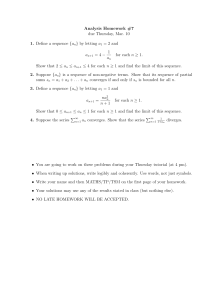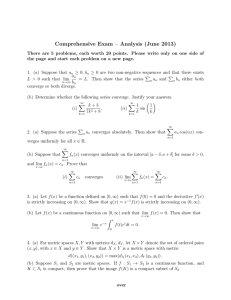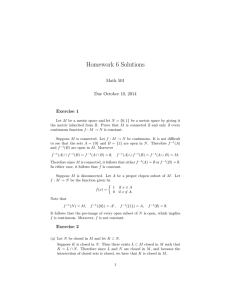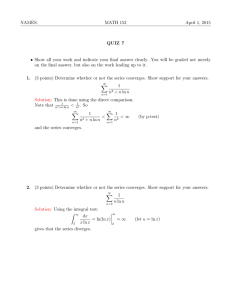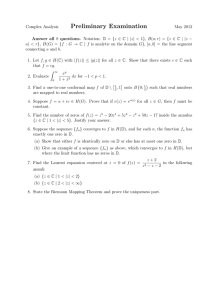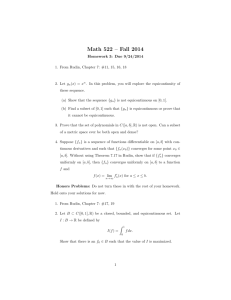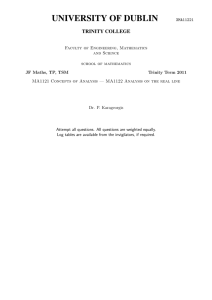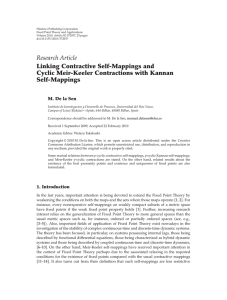Homework 4 Math 501 Due September 26, 2014 Exercise 1
advertisement
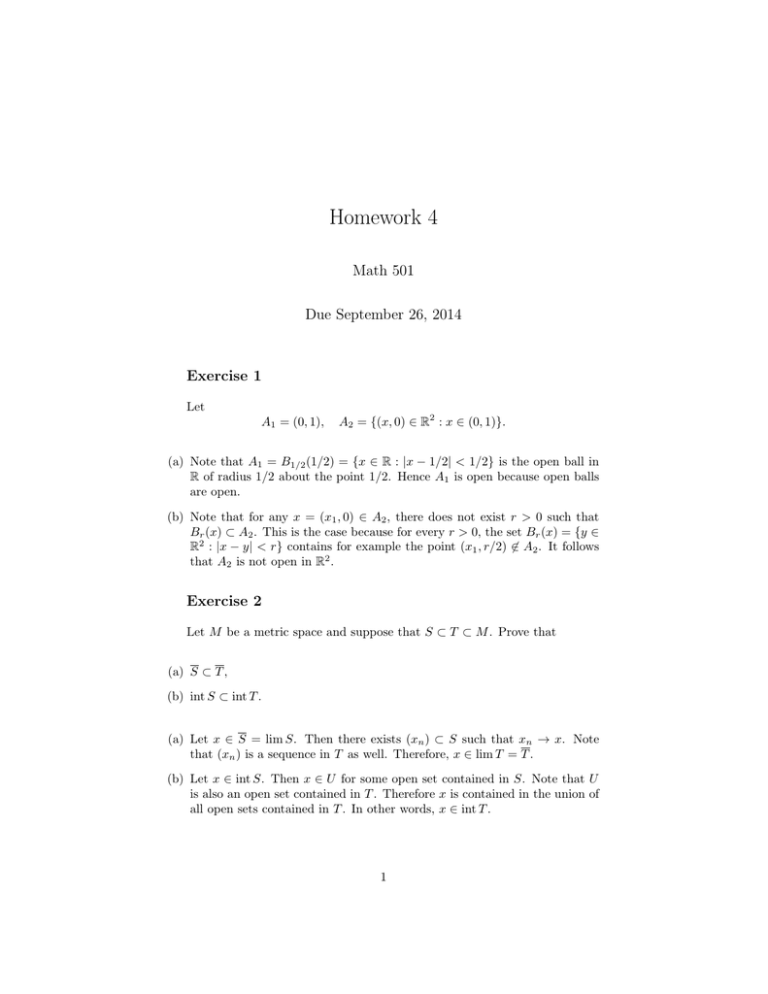
Homework 4
Math 501
Due September 26, 2014
Exercise 1
Let
A1 = (0, 1),
A2 = {(x, 0) ∈ R2 : x ∈ (0, 1)}.
(a) Note that A1 = B1/2 (1/2) = {x ∈ R : |x − 1/2| < 1/2} is the open ball in
R of radius 1/2 about the point 1/2. Hence A1 is open because open balls
are open.
(b) Note that for any x = (x1 , 0) ∈ A2 , there does not exist r > 0 such that
Br (x) ⊂ A2 . This is the case because for every r > 0, the set Br (x) = {y ∈
R2 : |x − y| < r} contains for example the point (x1 , r/2) 6∈ A2 . It follows
that A2 is not open in R2 .
Exercise 2
Let M be a metric space and suppose that S ⊂ T ⊂ M . Prove that
(a) S ⊂ T ,
(b) int S ⊂ int T .
(a) Let x ∈ S = lim S. Then there exists (xn ) ⊂ S such that xn → x. Note
that (xn ) is a sequence in T as well. Therefore, x ∈ lim T = T .
(b) Let x ∈ int S. Then x ∈ U for some open set contained in S. Note that U
is also an open set contained in T . Therefore x is contained in the union of
all open sets contained in T . In other words, x ∈ int T .
1
Exercise 3
Let M be a metric space and let A ⊂ B ⊂ C ⊂ M . Suppose that A is dense
in B and B is dense in C. To show that A is dense in C it suffices to show that
for every c ∈ C, there exists a sequence (an ) ⊂ A such that an → c.
Let c ∈ C and > 0. Since B is dense in C, there exists a sequence (bn ) ⊂ B
such that bn → c. That is, there exists N 0 such that
d(bn , c) < /2
for all n ≥ N 0 . Note that since A is dense in B, for each n ≥ 1, there exists a
(n)
(n)
sequence (am ) ⊂ A such that am → bn as m → ∞. That is, for each n ≥ 1,
there exists Nn such that
d(a(n)
m , bn ) < /2
for all m ≥ Nn .
Let N = max{N 0 , NN 0 }. Then for n ≥ N , we have that
(n)
d(a(n)
n , c) ≤ d(an , bn ) + d(bn , c) < .
(n)
Therefore the sequence an = an
is a sequence in A that converges to c.
Exercise 4
(a) We first claim that any singleton set {n} ⊂ N is open. Indeed, observe that
for any r ∈ (0, 1), the ball Br (n) = {m ∈ N : |n − m| < r} = {n}. Next
consider any subset S ⊂ N. Note that S is the union of open sets– namely
the union of singletons– and hence open. Thus any subset of N is open. In
particular, S c is open as well, which implies S is closed.
(b) Let M be a metric space and let f : N → M be a function. Note that if
U ⊂ M is open, then f −1 (U ) is open in N since every subset of N is open.
Hence f is continuous.
Exercise 5
Let M be a metric space, let S ⊂ M be a non-empty subset, and let p ∈ M .
Define
dist(p, S) = inf{d(p, s) : s ∈ S}.
Suppose that p ∈ lim S. Then there exists a sequence (pn ) ⊂ S such that
pn → p. Thus for any > 0, there exists N such that d(pn , p) < . Therefore
0 ≤ d(p, S) ≤ d(pn , p) < ,
2
which implies dist(p, S) = 0.
Conversely suppose that dist(p, S) = 0. Note that for every > 0, there
exists q ∈ S such that
0 = dist(p, S) ≤ d(p, q) ≤ dist(p, S) + = .
Therefore, for every n ≥ 1, there exists qn ∈ S such that
0 ≤ d(p, qn ) ≤
1
.
n
It follows that the sequence (qn ) ⊂ S converges to p. Hence p ∈ lim S.
Exercise 6
Let (xn ) ⊂ R be a sequence that converges to say x ∈ R. It is straightforward
to check that the function f : R → R given by f (x) = |x| is continuous. From
this it follows that f (xn ) → f (x). In other words, the sequence (|xn |) converges.
Exercise 7
(a) Let f : R → R2 be given by f (x) = (x, 0). It is straightforward to see that
f is a homeomorphism onto its image.
To see that f (R) is closed, let (xn , yn ) ∈ f (R) be a sequence that converges
to (x, y) ∈ R2 . To see that f (R) is closed, we must show that (x, y) ∈ f (R).
Note first that it must be the case that yn = 0 for all n ≥ 1, from which it
follows that y = 0. Therefore (x, 0) = f (x) ∈ f (R).
(b) Let N = (0, 1) ∈ R2 denote the so-called “north-pole” of S 1 . Consider the
map g : R → S 1 \ {N } which is defined as follows. For each x ∈ R, consider
the line `x ⊂ R2 which connects (x, 0) and N . Define g(x) ∈ R2 to be the
point of intersection of `x with S 1 \ {N }.
(i) Let p ∈ R be nonzero. Note that the line `p has Cartesian equation
y = −x/p + 1. To find the point of intersection of `p with S 1 \ {N }
we solve the system
y = − xp + 1
x2 + y 2 = 1.
A straightforward computation shows that (2p/(p2 + 1), (p2 − 1)/(p2 +
1)) solves the system. It is easy to see that
2p
p2 − 1
g(p) =
,
p2 + 1 p2 + 1
is continuous.
3
(ii) To see that g is a homeomorphism, it suffices to show that g has an
inverse and that inverse is continuous. To find the inverse of g, first
suppose (u, v) ∈ S 1 \ {N }. The line which passes through N and (u, v)
is given by the Cartesian equation
y=
v−1
x + 1,
u
which clearly passes through the x-axis at u/(1 − v). It follows that
g −1 (u, v) =
u
,
1−v
which again is clearly continuous.
(c) There cannot exist an embedding which maps R into a closed and bounded
subset of R2 because this would imply that R is homeomorphic to a compact
set, which in turn would imply R is compact, which is not the case.
4


